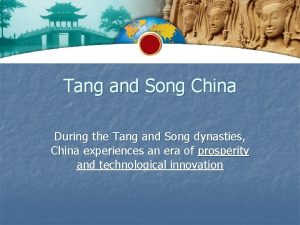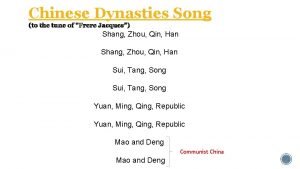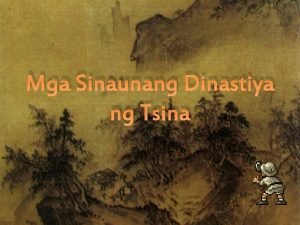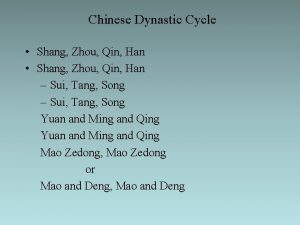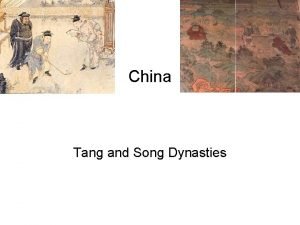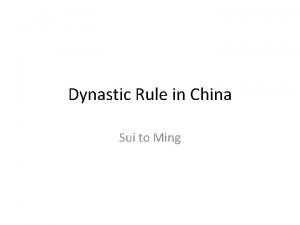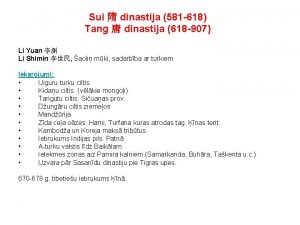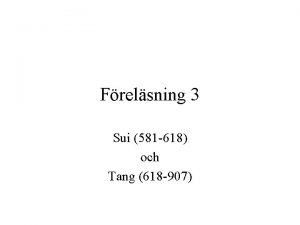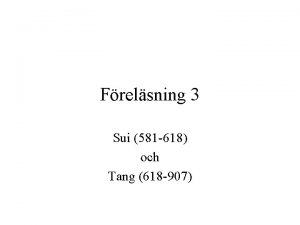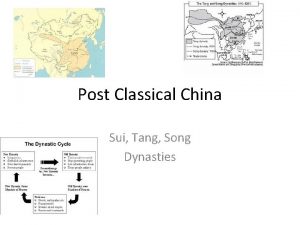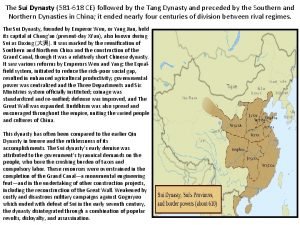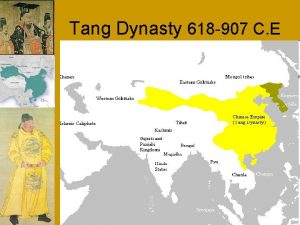Sui 581 618 and Tang 619 960 China

















- Slides: 17

Sui (581 -618) and Tang (619 -960) China October 10, 2013

Review • What was the relationship between the peoples of India and the peoples of Central Asia? • What were the differences between northern India and southern India? • What is the difference between Vedic religion and Hinduism? • Who were the Yuezhi?

Religious Change Buddhism entered China near the end of the Han but faced many obstacles. However, after the Han fell, it became the dominant religion, particularly in the north. Buddhism became sinified. It became a Chinese religion. Religious Daoism also emerged in the late Han, and borrowed many institutional features (temples, monks, etc) from Buddhism Confucianism developed new family rituals.

Sui and Tang China The Rapid rise and fall of the Sui Reunification, the Grand Canal, and defeat at the hands of Koguryŏ Tang: China’s “Golden Age” Bureaucracy gains on the aristocracy The Tang Law Code The Six Ministries and the Censorate The Tang turns slightly away from Buddhism

The Han move to the south In 400 BCE only 20% of the Han (ethnic Chinese) population lived in the Yangzi river area and farther south. That rose to almost 50% by late Tang. First the Han had to tame the floods and the malaria of south China. Once they did that, they found they could grow much more than they could up north. But the land-owning aristocracy of the north had to leave their land behind when they moved south, and had to find new ways to claim elite status. They turned to scholarship and the civil service exams. They become bureaucrats rather than aristocrats.

Changes in Chinese society • • Shang---a small ruling class of chariot-riding warriors. Zhou --feudalism--both control of force and control of ritual used to maintain power. Status is hereditary. Han--an educated aristocracy replaces warriors as feudalism declines Tang--bureaucrats began to challenge aristocrats. Landownership and education grew in importance.

Aristocrats and Bureaucrats • • aristocrat: someone whose high status and power are due to their family background. Aristocrats thus are somewhat independent of government, particularly of the emperor, because they have an independent power base in their landholdings and in their inherited charisma bureaucrat: an appointed government official who has certain duties and responsibilities defined by this position in the bureaucracy. Since his official power comes from his official appointment, he is more dependent than an aristocrat on the government which appointed him.

Tang government Rule by law: there was a law code applied throughout the empire. There were six ministries (Personnel, Revenue, Rites, War, Punishments, and Public Works), plus a Censorate The central government appointed local officials. This is not feudalism.

Women of Tang Empress Wu-- r. 690 --706 Called herself the Maitreya Buddha Yang Guifei--(719 -56) the beauty who brought down an empire Women, with unbound feet, played polo

Tang and its Neighbors The Tribute system China as centre of the world Tang was a cosmopolitan society, with many foreign residents 751 was a bad year: defeated by Arabs in the west, Khitan (Qidan) in the north, and Nanzhao in the south Tibet: In 695 Tibet inflicted a major defeat on the Tang. In 763 Tibetan forces captured the Tang capital temporarily.

Neighbouring countries • • Northern Vietnam is the Chinese territory of Annam Tibet is strong and at war with Tang Turks--fighting back and forth The rise of the Uighur allied state Japan--limited ties Korea: Tang and Silla defeat Koguryŏ and Paekche. Silla becomes a tributary state. Parhae (Pohai) is also a tributary state. India and Southeast Asia: envoys (and tribute) exchanged with some states.

Map of Tang • http: //depts. washington. edu/chinaciv/1 xarta ng. htm

Independent Tibet For most of the Tang, Tibet was a strong rival of the Tang, not only defending its border but also attacking across the Tang borders and seizing Tang territory. Tibet first encountered Buddhism during the Tang. Eventually Tibet developed its own form of Buddhism, which goes beyond the Mahayana Buddhism of bodhisattvas to teach esoteric techniques for reaching enlightenment/nirvana faster.

Tang Culture Guanyin (Bodhisattva of Compassion) becomes depicted as female. Porcelain (China) is invented Tri-color glazed pottery is developed Tang poetry: • Regulated verse • Free-flowing verse (like Turkish folk songs) • China’s greatest poets: Li Bo and Du Fu

A Li Bai Poem • 對酒不 覺瞑 落花盈我衣 醉起步溪月 鳥還人亦稀 • Facing Wine--I don’t notice the dusk Falling flowers cover my robe Drunkenly I rise, and walk with the moon in the stream Birds have gone back, and people are few.

Impact of buddhism The Tang temporarily withdrew most official support for Buddhism in 845 --Buddhist temples took too much land off the tax rolls, and monks were exempt from corvée labour (the payment of taxes in the form of unpaid labour on government projects. ) Nevertheless, Buddhism survived among the people of Tang and beyond, became a major component, along with Daoism and local gods, of the folk religion of China. It filled the gap in people’s spiritual lives Confucianism did not yet fill. Buddhism diversified such that we can talk about different schools of sutra-based (philosophical) Buddhism, Chan (meditative) Buddhism, and Pure Land Buddhism (Buddhism of devotion and chanting. )

The People of Tang We call the dominant ethnic group in China the Han, using the name of the first stable Chinese empire. However, people in southern China often refer to themselves as “people of the Tang, ” since it is under the Tang that they became Chinese--before the Tang the cultural and economic centre of China was in the north but from the Tang on, with more Chinese living in the south than in the north, the Yangzi river and farther south became the economic and cultural (though not political) centre of China.
 China song menu
China song menu How did the sui and tang dynasties reunite china
How did the sui and tang dynasties reunite china Sui tang song dynasties
Sui tang song dynasties Han sui tang song
Han sui tang song Sui tang and song dynasties
Sui tang and song dynasties Chinese dynasties in order song
Chinese dynasties in order song Hsia dinastiya
Hsia dinastiya Shang zhou qin and han dynasties
Shang zhou qin and han dynasties Cê sủi
Cê sủi Fsebo
Fsebo Sui tang song
Sui tang song Tang and song venn diagram
Tang and song venn diagram Chapter 12 section 1 tang and song china
Chapter 12 section 1 tang and song china Princess anle
Princess anle How did the sui dynasty affect daily life in china
How did the sui dynasty affect daily life in china Articulo 619
Articulo 619 Pingo upb
Pingo upb Xkcd #619
Xkcd #619
